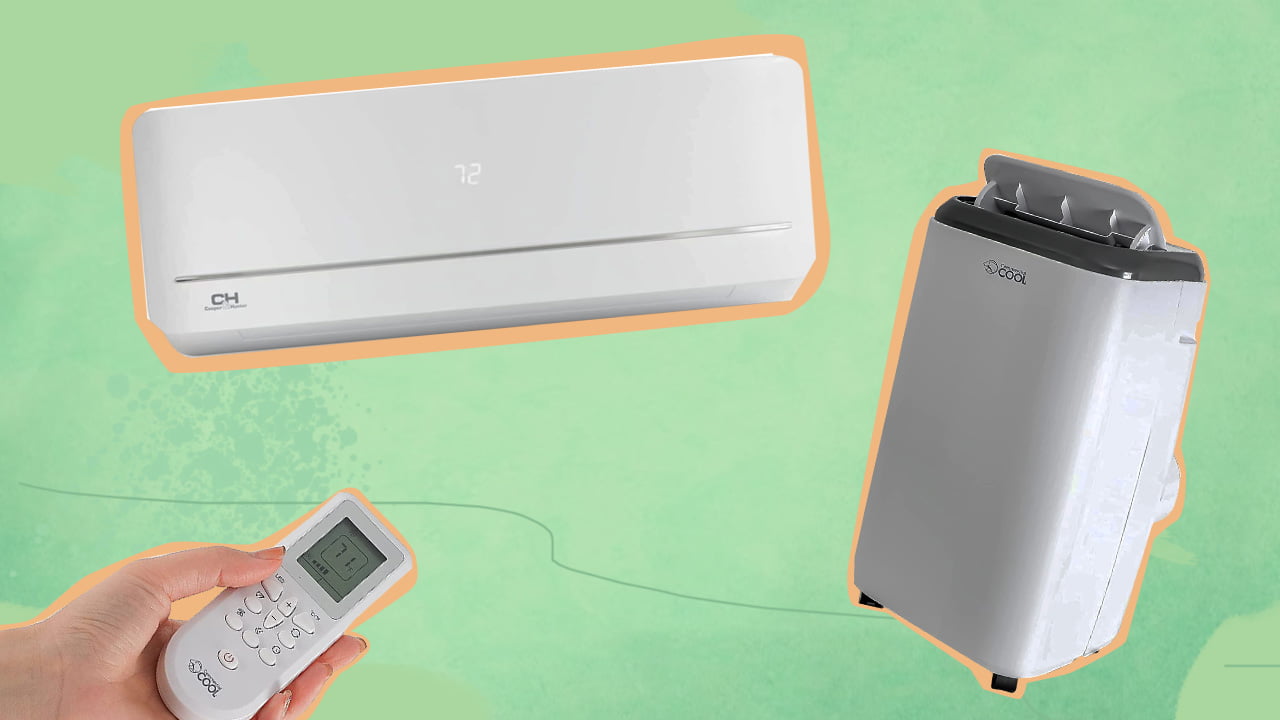Ductless mini split systems offer more features, better control, and cool a larger area. They can also release both cool and warm air, so you can use them all around the year. Meanwhile, portable ACs are energy efficient, easy to move, and cost-effective.

Not sure whether to install a ductless mini split system or a portable one?
It could be confusing to make a decision, especially if you are not well-versed in their features. Both types of air conditioners have their own pros and cons.
If you are looking for a versatile unit, a mini-split would be better. But if you want something easier to maintain, portable ACs are what you need. Need more pointers like these?
Keep on reading!
Features Of A Mini Split Unit

A mini-split is an air conditioning system that lets you adjust the temperature in separate rooms or spaces. It has two main components - an indoor air handling unit (also called an evaporator) and an outdoor condenser or compressor.
These units are very easy to install, as they require only a 3-inch wide hole in a wall for the conduit. It houses communication and power cables, a copper tube or duct, and a condensation drain line, which connects the indoor unit to the outdoor one.
Mini Splits are a great fit for homes that have non-ducted heating or cooling systems. They are also perfect if you make a room addition in your house and installing or extending ductwork is not possible.
Features Of Portable Air Conditioners
A portable air conditioner is a self-contained cooling device that can be set up anywhere in the house. It primarily sucks in the hot air from the room, extracts the heat from it, conditions it to your preferred temperature, and releases it.
These four basic components enable a portable AC to cool the space efficiently - an evaporator coil along with the refrigerant, compressor, condenser coil, and fan. It removes moisture from the air through self-evaporation, gravity drain, and its internal bucket.
The best part is these units are very simple to install and won’t even require any professional help. They are lightweight and generally come with attached wheels, so you can move them from one room to another conveniently.
Differences Between Mini Split And Portable Air Conditioners
Now that I have told you about the basic features of mini-split systems and portable air conditioners, let’s understand the differences between the two. This will give you some idea about which option is better and why.
1. Appearance
Mini split and portable air conditioners vary a great deal in terms of appearance. The former is perched high on your ceiling or wall. It also comes with streamlined and sleek jackets that usually blend with the room décor. And for aesthetic installation, the outdoor unit can be installed up to 50 feet away from the indoor one.
Portable air conditioners, on the other hand, can be an eyesore in your home. Not only do they take up space, but they also need a flexible hose to function, which can disturb the décor and stand out from the rest of the room. So, in terms of appearance, a mini-split is definitely a better choice than a portable AC unit.
2. Functions
Mini-splits are essentially mini heat pumps that can both cool and heat your home. They are quite versatile when it comes to functionality and can be used year-round. These systems are also equipped with multiple fan settings, timers, and wireless remote control for optimum comfort and ease of use.
Window air conditioners and portable AC units can only be used in hot months for cooling the home. And as soon as the temperature drops, you will have to invest in a different system for heating purposes.
Not to forget, they are very loud and will produce a lot of noise during operation. But on the upside, a portable air conditioner can function as a dehumidifier and keep you safe from air pollution.
3. Convenience
Speaking of movability, portable air conditioners outshine mini splits as they can be moved easily and don’t need to be installed in a fixed place. However, mini splits are stationary, and it’s a hassle to change their position around the home. But they are more convenient in adjusting temperature and fan speed, which is not the case for portable units.
4. Cost
Mini-splits offer much more features, better functionality, and operation than portable air conditioners. So, inevitably they come with a much steeper price tag and lie in the range of $1,500 to $5,000. Meanwhile, you can buy the latter for $200 to $600.
So, if you have budget constraints, then a portable ac unit would be a better choice. But if you can shell out some cash, then I recommend opting for a mini-split, as it would be an excellent one-time investment.
Why Choose A Mini Split System?
A ductless mini-split would be an excellent fit for you for the following reasons:
1. All-around Control
Mini split systems offer all-around control during operation, which a portable air conditioner often fails to do. They come with remote control technology, and you can adjust the temperature of each room owing to the sensors. A mini split also has more speed settings and adjustment levels to provide you with comfortable heating and cooling.
And if you are a deep sleeper who doesn’t want to wake up in the middle of the night to turn off the air conditioning, these systems are equipped with timers. So, all you need to do is set the time, and it will turn off automatically. This feature is generally unavailable in portable air conditioners.
2. Versatile Functioning
Another great thing about a mini split is that it can be used in both summer and winter, as it has a heat pump. Even though it is pricier than a portable air conditioner, you won’t have to buy a separate AC and a heater, so it would save you more money in the long run.
3. Scalable
Unlike a portable air conditioner, a mini-split is scalable and can be used to cool one room to the whole house. Many models have i-see sensor technology that directly points the airflow to the source of the heat. So, you get the best of both worlds with mini splits, while portable units are best suited for spot cooling.
4. Whisper-quiet Technology
While a portable air conditioner is noisy, a mini-split is quite the opposite. It has whisper-quiet technology, and for the most part, you won’t even realize that the system is running. This makes it perfect for light sleepers who prefer a quiet environment while snoozing.

Why Choose Portable AC Units?
1. Easy Setup Without Permanent Installation
The best thing about a portable air conditioner is that it doesn’t require professional installation. All you need to do is place it in your preferred spot, ensuring that it is near a window for plugging the flexible exhaust hose, and you’d be good to go. Not only does it save installation costs, but you also won’t have to commit to a particular part of your home.
Furthermore, it is perfect if you have multiple guest rooms and people keep coming over, as you can roll it from one room to another.
2. Cools And Dehumidifies: Constant Air Quality Control
While a portable AC unit isn’t as versatile as a mini-split, it can still be used for two purposes. Not only does it release cool air, but it also dries it. Meaning you can also use this system as a dehumidifier. If you live in a humid area, you know how bad it can get during peak summers.
Cooling alone cannot give you relief in such weather, so it’s important to have a system that sucks out the moisture from the air and enhances indoor air quality. And a portable air conditioner can help you out with that.
3. Cut Back On Your Energy Bills
Lastly, a portable air conditioner is more energy-efficient than a ductless air conditioner. That’s because it spot cools a particular part of the room instead of the whole house. Because honestly, what is even the point of firing up the central thermostat if you are going to hang out in one part of the house all day long?
With a portable air conditioner, you can simply cool a particular room. The required temperature will be attained quickly, so you will naturally use the unit for shorter durations. And trust me, this will help you cut back on your energy bills quite a bit.
Tip
I have an important tip for you that can help you make an informed decision. When buying an air conditioner, ask yourself these three questions for more clarity:
- What is the area I need to cover?
- Do I need a permanent installation or a temporary one?
- Do I need something cheap, or can I shell out some extra bucks?
This will help you decide whether a ductless air conditioner (a mini-split system) is better suited for you or a portable one.
Things To Consider When Buying An Air Conditioning Unit
Doesn’t matter if you choose ductless systems or portable; pay attention to these features to make a better choice:
- Electricity consumption
- Seasonal energy efficiency ratio
- Refrigerant requirement
Portable air conditioners usually have an average lifespan of between 5 and 10 years. However, if you take care of them, they will last up to 15 years. Much like portable air conditioners, mini-split air conditioning systems last for about 10 to 20 years. Nevertheless, only air conditioners purchased from reliable manufacturers will last this long. Otherwise, units built using inferior materials won’t last long, meaning they’ll keep breaking down every now and then. Between portable air conditioners and mini-split air conditioners, mini-split air conditioners last long. So, if longevity tops your list, I’d suggest going for mini-split systems. Also, remember that the lifespan of air conditioners generally depends on how well the unit is maintained. With proper maintenance, your unit can last up to 15 to 20 years. Both portable air conditioners and mini-split systems consume an equal amount of energy to cool a room. However, mini-split air conditioners with zoning systems are more energy-efficient than regular split systems and portable air conditioning units, as stated by the United States Department of Energy. Precisely, mini-split units with zoning systems consume 30 percent less energy. Less energy consumption means less energy bills– so you’ll save a generous amount every month. Yes, portable air conditioners are cheaper than mini-split systems. Not only mini split systems, but they are also cheaper than central air conditioning units. Even the most advanced portable air conditioner can be purchased within $1,000. That means you can purchase 2 or more portable air conditioners without spending a fortune. For cooling small spaces, portable air conditioners are excellent because they cool small spaces efficiently. At the same time, they won’t be the right choice for cooling large rooms because they would consume a lot of energy, skyrocketing your utility bills. However, you can go for mini-split systems to cool a small room because they cool a space relatively quicker than portable air conditioners. Of course, your budget and needs will help you decide which system to go for, so take them into consideration. Yes, mini split air conditioners, like portable air conditioning systems, are easy to install, and seasoned DIYers will be able to pull off the task with ease. Just make sure to go through the instructions in the manual, and I’m sure you’ll be able to complete it without hassle.Portable Vs Mini-Split AC FAQs

Conclusion
That said, I have reached the end of my informative guide on mini split vs. portable air conditioners. Let me do a quick rundown to put things in perspective.
Mini split systems are a good option if you want to cool a larger area while maintaining the aesthetic of your room. They provide better control and more comfortable temperature adjustments and are ductless air conditioners with easy installation.
A portable air conditioner, on the other hand, lags behind in terms of functionality and scalability. But it provides easy setup, optimum ventilation, and air conditioning, offering efficient energy use. It also takes up less space and can be moved around easily.
